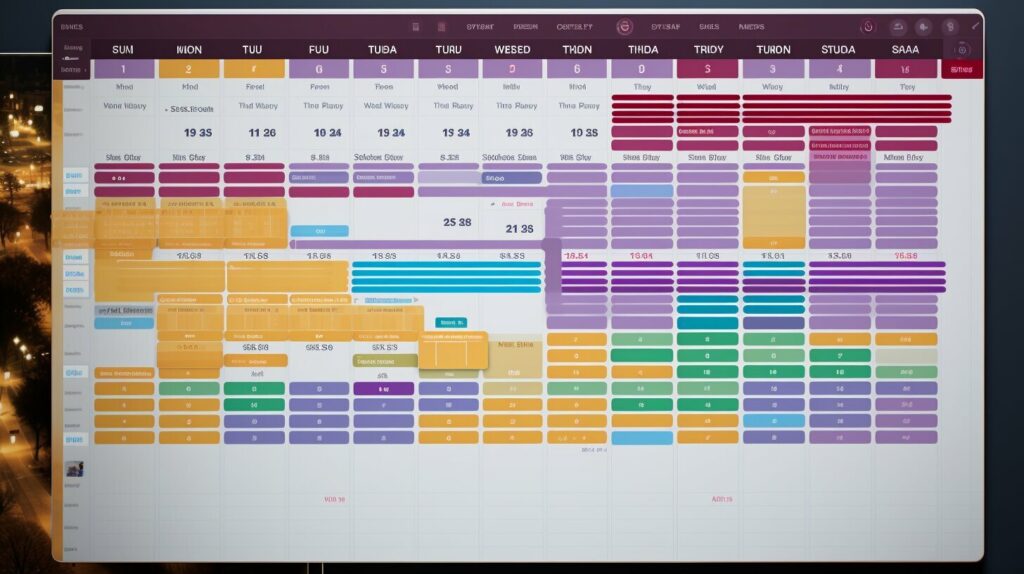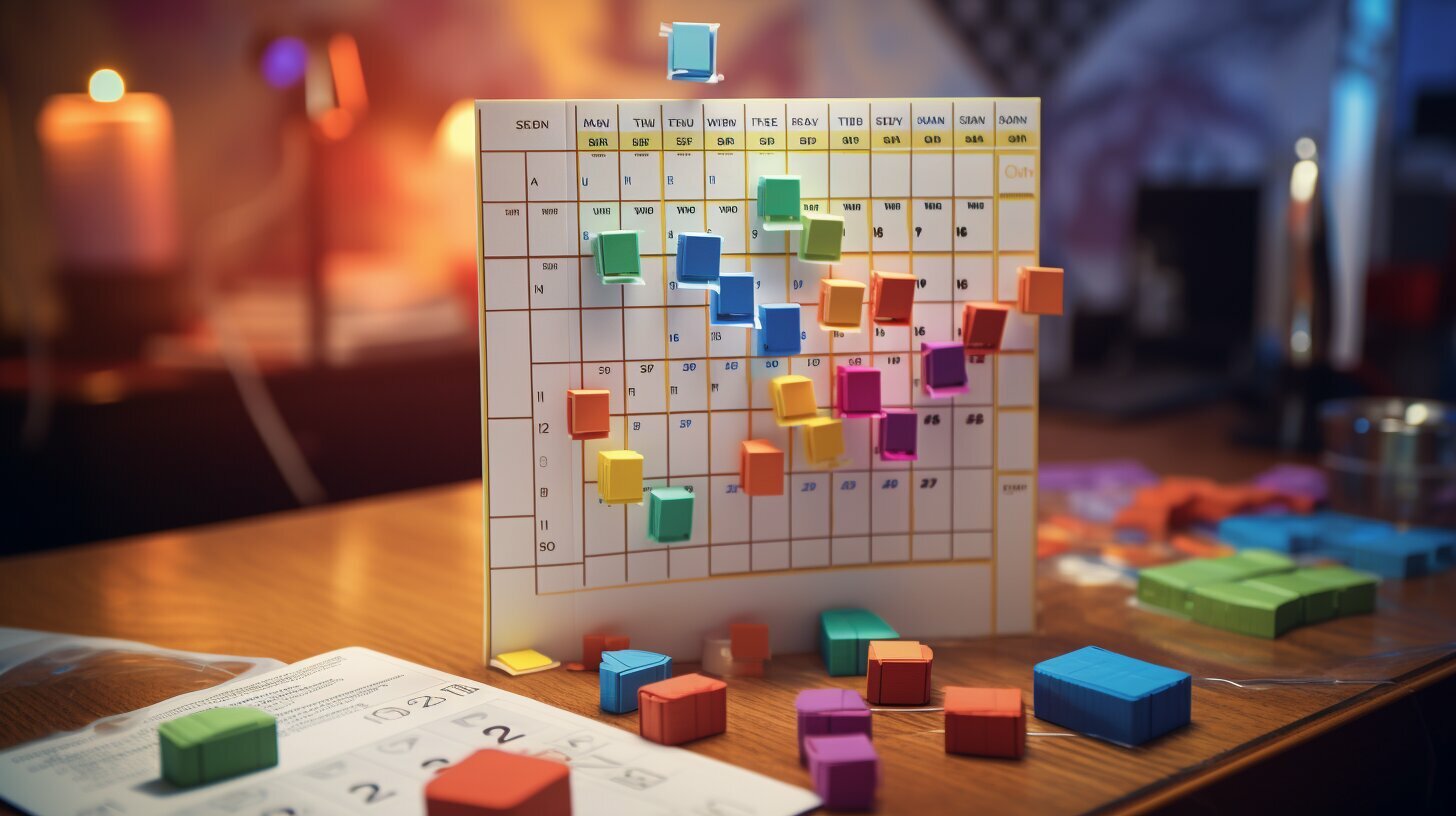Welcome to our comprehensive guide on co-parenting schedules. Co-parenting can be a challenging journey, but with the right strategies and mindset, you can create a positive co-parenting environment that benefits everyone involved, especially your children. In this guide, we will provide you with valuable insights and tips to help you master co-parenting schedules and navigate the complexities of co-parenting.



Key Takeaways:
- Effective communication is key to successful co-parenting
- A comprehensive co-parenting agreement serves as the foundation for a smooth schedule
- Designing an effective schedule requires careful consideration of various factors
- Child’s emotional well-being should be a top priority in co-parenting
- Co-parenting schedules may require adjustments over time
Understanding Co-Parenting Dynamics
Co-parenting is a dynamic relationship that involves shared parenting responsibilities between two adults who are no longer in a romantic relationship. Understanding the dynamics of co-parenting is crucial for successful co-parenting schedules.
The Benefits of Co-Parenting
Co-parenting offers numerous benefits for children, with research indicating that they do better emotionally, behaviorally, and academically when they have consistent and positive relationships with both parents. Co-parenting also allows both parents to have an active role in their children’s lives.
Common Challenges Faced by Co-Parents
Despite the benefits, co-parenting is not always easy. Some common challenges that co-parents face include disagreeing on parenting styles, differences in schedules, and communication breakdowns. These challenges can strain the co-parenting relationship and lead to conflicts that affect the children.
Importance of Effective Communication
Effective communication is essential for a successful co-parenting relationship. Co-parents should establish clear communication protocols for discussing parenting decisions and scheduling changes. Communication should be respectful, concise, and focused on the needs of the children. Maintaining a positive tone and avoiding blaming or criticizing the other parent can help foster a healthy co-parenting dynamic.


“Effective communication is 20% what you know and 80% how you feel about what you know.”
– Jim Rohn
Creating a Co-Parenting Agreement
A well-crafted co-parenting agreement serves as the cornerstone for establishing a smooth co-parenting schedule. Creating an agreement may seem daunting, but it doesn’t have to be. In this section, we will provide you with practical tips on how to create a comprehensive agreement that covers various aspects such as custody arrangements, decision-making, communication protocols, and more.
1. Start with a Template
There are numerous templates available online that you can use as a starting point. These templates provide a comprehensive outline of the various elements that should be included in a co-parenting agreement. As you review the templates, consider which elements are most relevant to your situation and customize the agreement accordingly.
2. Be Specific and Detailed
The more specific and detailed your co-parenting agreement is, the more effective it will be in guiding your co-parenting schedule. Include details such as the exact days and times each parent will have parenting time, transportation arrangements, holiday and vacation schedules, and guidelines for making major decisions regarding your children’s education, healthcare, and other important matters.
3. Keep Your Child’s Best Interests in Mind
The ultimate goal of the co-parenting agreement is to promote your child’s well-being. Keep this in mind as you create the agreement. Avoid putting your child in the middle of conflicts or using the agreement as a means of punishing your co-parent. Instead, use the agreement to establish a healthy co-parenting relationship that benefits your child.
4. Seek Legal Advice
If you have any concerns about the legal aspects of your co-parenting agreement, seek advice from a qualified family law attorney. They can advise you on any state-specific requirements that should be included in the contract and help ensure that your agreement is legally enforceable.
By following these tips, you can create a comprehensive co-parenting agreement that serves as a solid foundation for your co-parenting schedule, promoting stability and consistency for your children.


“A well-crafted co-parenting agreement serves as the cornerstone for establishing a smooth co-parenting schedule.”
Designing Your Co-Parenting Schedule
Designing a co-parenting schedule can be a complex and challenging process. However, it is essential to ensure that the schedule is effective and sustainable for the long run. Here are some factors to consider when designing your co-parenting schedule:
Types of Co-Parenting Schedules
There are various types of co-parenting schedules to choose from, depending on the needs and preferences of you and your co-parent. Some common types include:
- Alternating weeks: Children spend one week with each parent on a rotating basis.
- 2-2-5-5 schedule: Children spend two days with one parent, two days with the other parent, and then five days with the first parent, followed by five days with the other parent.
- Bird nesting: Children stay in one home while parents take turns living with them.
It’s important to choose a schedule that suits your children’s age, school, and activity schedules while ensuring that both co-parents have meaningful parenting time.
Determining Parenting Time
When determining parenting time, there are a few factors to keep in mind:
- The age and needs of the children: Younger children may require more frequent transitions between homes.
- Work schedules and other commitments: Both co-parents should have a fair amount of parenting time while accommodating work and other commitments.
- The distance between homes: If the co-parents live far away from each other, it may not be practical to have a schedule with frequent transitions.
You may also want to consider including a provision for flexibility in case of unexpected events or changes in the schedule.
Promoting Fairness and Flexibility
Flexibility is key in co-parenting, and it’s important to promote fairness in the schedule. Here are some strategies to achieve this:
- Establish a regular check-in routine with your co-parent to discuss any concerns or changes in the schedule.
- Consider alternating holidays and special occasions every other year to ensure both co-parents have equal opportunities to spend time with their children.
- Find ways to accommodate each other’s preferences and needs to promote a positive co-parenting relationship.
By considering these factors and strategies, you can design an effective and sustainable co-parenting schedule that meets the needs of your family members.


Communication Strategies for Co-Parents
Effective communication is key to successful co-parenting. Whether it’s coordinating schedules or making important decisions about your child’s welfare, being able to communicate openly and respectfully with your co-parent can help minimize conflicts and ensure a positive co-parenting environment.
Here are some essential communication strategies for co-parents:
1. Set Clear Boundaries
Establishing clear boundaries can help reduce misunderstandings and conflicts. Make sure to discuss and agree on communication protocols and expectations, such as preferred methods of communication, response time, and the types of topics that are appropriate for discussion.
2. Use Technology Tools
Technology can be a valuable tool for co-parents to communicate and stay organized. Utilize shared calendars, messaging apps, and cloud storage to keep track of schedules, appointments, and important information. This can help avoid miscommunication and confusion.


3. Maintain a Respectful Tone
It’s important to communicate in a respectful and constructive manner, even when disagreements arise. Avoid using negative language or making personal attacks, as this can escalate conflicts and damage the co-parenting relationship.
4. Use “I” Statements
When expressing your needs or concerns, use “I” statements instead of placing blame. For example, instead of saying, “You never pick up the kids on time,” try saying, “I feel frustrated when the kids aren’t picked up on time.”
5. Be Flexible
Try to be flexible and open-minded when communicating with your co-parent. Listen to their perspective and be willing to compromise when necessary. This can help foster a positive co-parenting relationship and promote a sense of teamwork.
By utilizing these communication strategies, co-parents can establish a healthy and effective way of communicating that benefits everyone involved.
Co-Parenting Tools and Apps
In today’s digital age, co-parenting has become more manageable with the help of various tools and apps. These tools make it easier to communicate, share important information, and manage co-parenting schedules effectively. Here are some of the most popular co-parenting tools and apps:
OurFamilyWizard
OurFamilyWizard is a comprehensive app that helps co-parents manage their schedules, communicate effectively, and share important information. It has a shared calendar that both parents can access to keep track of parenting time, appointments, and other activities. Additionally, it offers features like messaging, expense tracking, and document storage, making communication and coordination more streamlined.
2houses
2houses is another popular co-parenting app that allows parents to share a calendar, communicate, and manage expenses. It also includes features like a journal and a photo album, which can help both parents stay up-to-date on their children’s lives. The app has a user-friendly interface that makes it easy to navigate and use.
Cozi
Cozi is a multipurpose app that can be used for co-parenting as well. It has a shared calendar that can be accessed by both parents, allowing them to coordinate schedules and appointments. Additionally, it has a to-do list feature, which can help keep track of tasks related to co-parenting. The app also allows users to set reminders, helping them stay on top of important events and deadlines.
TalkingParents
TalkingParents is an app designed to facilitate communication between co-parents, particularly in high-conflict situations. It includes features like secure messaging, a shared calendar, and a journal that can be used to document important events and interactions. The app also tracks all communication, which can be useful in court or custody hearings.
Co-Parenter
Co-Parenter is an app that uses AI technology to help co-parents manage their schedules and communicate effectively. The app has a virtual assistant that can answer common questions related to co-parenting, such as how to handle certain situations or how to modify a parenting plan. It also offers tools to resolve disputes, including a mediator and a parenting coordinator.


Using co-parenting tools and apps can help simplify the process of co-parenting and make it more manageable. By using these tools, co-parents can remain organized, reduce conflicts, and provide their children with a stable and nurturing environment.
Managing Co-Parenting Conflicts
Co-parenting can be challenging, and conflicts are an inevitable part of the journey. However, how you handle conflicts can make a significant impact on your co-parenting relationship and your children’s emotional well-being. Here are some strategies for managing co-parenting conflicts:
Focus on Your Children
When conflicts arise, it can be easy to get caught up in your personal feelings and lose sight of the bigger picture. Remember that your children’s well-being should always be your top priority. Put your differences aside and focus on finding solutions that are in the best interest of your children. Keep communication respectful and constructive, avoiding blame and criticism.
Establish Boundaries
It’s essential to set clear boundaries for your co-parenting relationship to prevent conflicts from escalating. Decide on how you will communicate, whether it’s through email, text, or a co-parenting app. Also, establish rules regarding when and where you will exchange your children. Having clear boundaries can minimize misunderstandings and conflicts.
Be Flexible
Flexibility is key to successful co-parenting. Understand that changes happen, and your co-parent may need to deviate from the schedule at times. Be open to negotiating and compromising, always keeping your children’s best interest in mind. If you need to make a change, communicate it respectfully and as early as possible.
Seek Mediation
If conflicts persist, it may be helpful to enlist the help of a mediator. A neutral third party can facilitate a discussion and help you find common ground. Mediation can be especially beneficial when making significant decisions, such as changes to the co-parenting agreement.
“When conflicts arise, it can be easy to get caught up in your personal feelings and lose sight of the bigger picture.”
Stay Positive
It’s challenging to co-parent with someone you don’t get along with, but maintaining a positive attitude can help. Treat your co-parent with respect and kindness, even when they don’t do the same. Keep your focus on the big picture, remembering that your children benefit from a positive co-parenting relationship.


Conclusion
Managing conflicts is an essential part of co-parenting. With the right strategies and a commitment to your children’s well-being, you can navigate conflicts constructively and maintain a positive co-parenting relationship. By focusing on your children, setting boundaries, being flexible, seeking mediation when necessary, and staying positive, you can create an environment that supports your children’s emotional health and well-being.
Co-Parenting and Child’s Emotional Well-Being
When it comes to co-parenting, the well-being of your children should always be the top priority. Ensuring that they receive the support they need during this process can help them develop healthy coping mechanisms and maintain overall emotional stability.
The Importance of Prioritizing Emotional Health
During this transition, it’s important to acknowledge that your child may experience a range of emotions, including confusion, sadness, or frustration. By prioritizing their emotional health, you can help them feel supported and cared for during this time.
Consider incorporating the following strategies to support your child’s emotional well-being:
- Open communication: Encourage your child to discuss their feelings, thoughts, and concerns with you or their co-parent. By creating a safe space for open communication, you can help your child process their emotions and develop effective coping mechanisms.
- Consistency and stability: Co-parenting schedules should aim to provide consistency and stability for your child. Maintaining a predictable routine can help them feel secure and less anxious about what each day may hold.
- Positive reinforcement: Encouraging your child’s achievements and providing positive feedback can help boost their self-esteem and promote a positive sense of self-worth.
Supporting Your Child Through Co-Parenting Schedules
Co-parenting schedules can be challenging for children, who may feel torn between two households. The following strategies can help create a positive co-parenting environment that benefits your child:
- Encourage flexibility: Flexibility is key in creating a co-parenting schedule that works for everyone involved. Be open to compromise and considerate of each other’s schedules to make the process as seamless as possible for your child.
- Minimize conflict: Conflict between co-parents can be detrimental to your child’s emotional well-being. Strive to maintain a respectful, civil relationship with your co-parent to create a welcoming and supportive environment for your child.
- Be attentive: Pay attention to your child’s behavior and mood during and after transitions. By being attentive and aware of your child’s needs, you can make adjustments to the co-parenting schedule as necessary, and provide additional support when needed.
Remember, as a co-parent, your child is looking to you for guidance and support during this time. By prioritizing their emotional well-being and fostering a positive co-parenting environment, you can help them navigate this process with ease.


Adjusting Co-Parenting Schedules Over Time
As your children grow and develop, their needs and preferences may change, and your co-parenting schedule will need to evolve accordingly. It’s essential to have a flexible approach to the schedule to accommodate these changes, which are a natural part of the co-parenting journey.
When adjusting your co-parenting schedule, it’s vital to prioritize your child’s well-being and continuity. Ensure that their emotional needs are met, and the adjustments don’t disrupt their routine or negatively impact their mental health.
Open and honest communication with your co-parent is essential when making adjustments to the schedule. Consider discussing the proposed changes with them and working together to find a solution that benefits everyone involved.
Special occasions and holidays are also an essential aspect of co-parenting scheduling, and it’s crucial to plan ahead for these events to avoid conflicts. Agreeing on a holiday schedule in advance can help you avoid misunderstandings and ensure that your children get to spend time with both parents during these special occasions.
When making schedule adjustments, remember to document the changes in your co-parenting agreement. This will ensure that both parties have a clear understanding of the new schedule, and it will serve as a point of reference in case of future disagreements.
Example of a Co-Parenting Schedule Adjustment
| Date | Original Schedule | Proposed Change | New Schedule |
|---|---|---|---|
| June 1-7 | Mom has custody | Dad has a work conference on June 5-6 and requests to swap custody to June 8-14 | Dad has custody from June 8-14, and Mom has custody from June 15-21 |
This table shows an example of a schedule adjustment from a week of custody with Mom to a week of custody with Dad due to a work conference. When making changes to the schedule, consider the timing and duration of the adjustment, the reason for the change, and how it will impact your child.
Remember that co-parenting is a journey, and it’s normal for the schedule to change over time. By maintaining open communication, prioritizing your child’s well-being, and documenting any changes, you can ensure that the co-parenting journey is a positive and successful one.


Conclusion
Congratulations on reaching the end of our guide for co-parenting schedules! We hope that our insights and strategies have equipped you with the tools to master co-parenting schedules and nurture a healthy co-parenting environment for the benefit of your children. Remember, co-parenting is a journey, and it may not always be easy. However, with effective communication, flexibility, and prioritizing your child’s emotional well-being, you can overcome challenges and create a positive co-parenting relationship.
Whether you’re just starting on your co-parenting journey or looking to make modifications to your existing schedule, it’s essential to keep in mind the importance of understanding co-parenting dynamics, creating a comprehensive co-parenting agreement, and designing an effective schedule. By doing so, you can avoid conflicts, minimize stress, and ensure that your children receive the support and care they need.
Remember, co-parenting is about sharing the responsibility of raising your children, and it’s essential to prioritize their emotional health throughout the process. By embracing efficient parenting strategies, nurturing open communication, and being flexible, you can create a positive co-parenting environment that supports your children’s overall well-being.



FAQ
What is co-parenting?
Co-parenting is a parenting arrangement in which separated or divorced parents share the responsibilities of raising their children together, even though they no longer live together.
Why is effective communication important in co-parenting?
Effective communication is crucial in co-parenting to ensure that both parents are on the same page and can make decisions together for the well-being of their children. It helps to minimize conflicts and create a positive co-parenting environment.
How can I create a co-parenting agreement?
To create a co-parenting agreement, sit down with your co-parent and discuss important aspects such as custody arrangements, decision-making, communication protocols, and more. It’s essential to include clear guidelines and expectations to establish a smooth co-parenting schedule.
What factors should I consider when designing a co-parenting schedule?
When designing a co-parenting schedule, consider factors like the age and needs of your children, work schedules, school activities, and transportation logistics. It’s crucial to create a schedule that is fair, flexible, and promotes the best interest of your children.
Are there any tools or apps available to help with co-parenting?
Yes, there are numerous tools and apps designed specifically for co-parenting. These tools can assist with organizing schedules, facilitating communication between co-parents, and managing expenses related to co-parenting responsibilities.
How can I manage conflicts with my co-parent?
To manage conflicts with your co-parent, it’s important to approach discussions with a calm and respectful attitude. Active listening, compromise, and seeking professional help if needed can also be effective strategies for resolving disputes and finding common ground.
How does co-parenting affect my child’s emotional well-being?
Co-parenting has a significant impact on your child’s emotional well-being. By prioritizing their emotional health, providing consistency and stability, and fostering open communication, you can create a supportive environment that promotes their overall well-being during the co-parenting journey.
What should I do if I need to adjust my co-parenting schedule?
If you need to adjust your co-parenting schedule, communicate openly with your co-parent and discuss the reasons for the modification. Consider the evolving needs and preferences of your children, and aim to find a solution that works for everyone involved. It’s also important to account for special occasions and holidays.





Leave a Reply